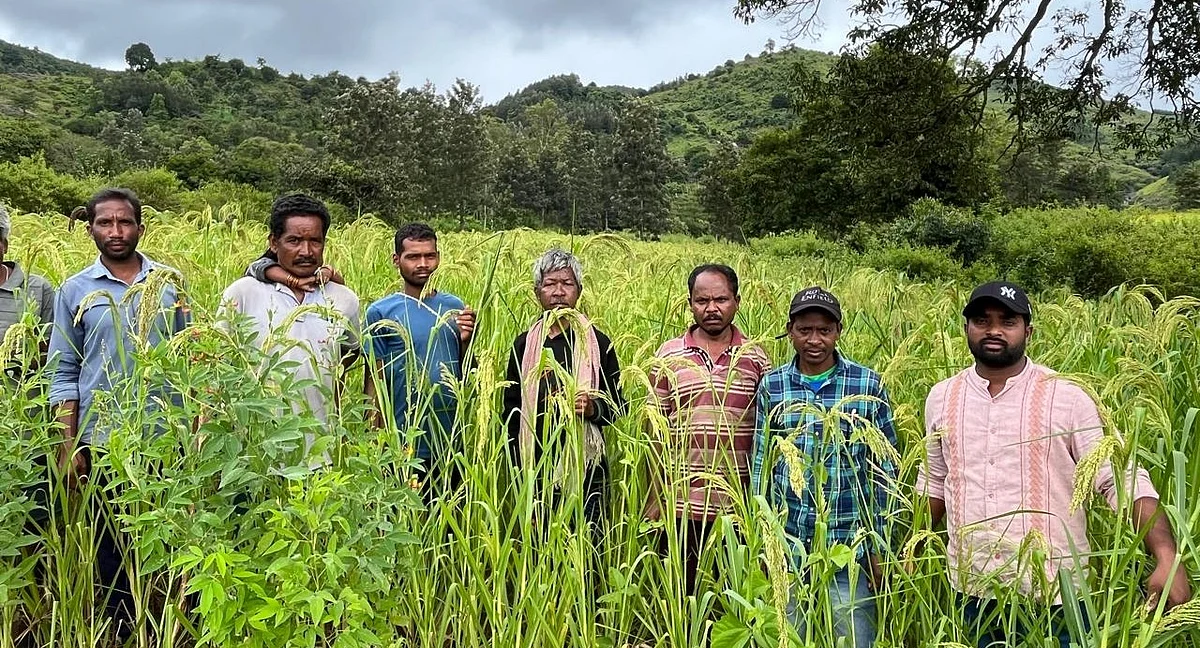Copyright downtoearth

Climate change is no longer a distant threat for the tribal communities of Andhra Pradesh—it is a lived reality. The high-altitude tribal areas and forests of Alluri Sitarama Raju, Parvathipuram Manyam districts, once abundant with crops, streams, and dense greenery, are showing visible signs of distress.Rising temperatures, erratic rainfall, and recurring forest fires are disrupting the delicate balance between nature and people that has sustained tribal life for millennia. The Andhra Pradesh State Action Plan on Climate Change (AP-SAPCC, 2020) and other study reports alert us to these climatic shifts which are hitting the poorest and most vulnerable the hardest—especially because they depend on rain-fed farming, forest produce, and traditional occupations.Agriculture in perilFor tribal farmers, agriculture has always been closely tied to the rhythm of the monsoon. But today, that rhythm has vanished and been replaced with erratic and unpredictable weather patterns. Increasing heat has been reducing soil moisture, while unseasonal rains have been damaging standing crops. Those like paddy and pulses have been showing declining yields under heat stress, while traditional millets—long neglected—have proven more resilient.Studies by the Indian Agricultural Research Institute (2012) and the Indian Council of Agricultural Research (2019) show that millets can thrive even in low-rainfall years, making them vital for food security in dry upland regions.Water scarcity has also become acute. The AP-SAPCC (2020) predicts a steady decline in rainfall during key crop-growing months (Rabi). Sudden heavy downpours now cause soil erosion and flooding. Strengthening watershed management and restoring traditional tanks are critical to rebuilding water security in tribal villages.For instance, a survey undertaken by Laya, a tribal resource centre, on the existing water harvesting structures including check dams, streams, and tanks meant for irrigation purposes in ASR and Manyam districts —revealed that they were about 81 in number and collectively catered to an extent of only 177 as opposed to 6,918 acres. Most of the check dams that have been constructed have remained non-functional. If repaired, they are likely to provide irrigation facilities to a larger extent from the existing 2.5 per cent!Therefore, the revival of traditional water-harvesting structures such as check dams and percolation ponds must be actively taken up under schemes like Mahatma Gandhi National Rural Employment Guarantee Scheme (MGNREGS).Livestock and fisheries, which serve as important resources for rural nutrition and income, are also under stress as an effect of Climate Change. Hotter temperatures reduce milk yield and fertility in cattle, while irregular rainfall affects fish breeding in inland waters, as reported by the National Bank for Agriculture and Rural Development (2019).Additionally, runoff from fields containing residual chemical fertilisers and pesticides is further exacerbating the problem, underscoring the urgent need for adapting organic farming practices.Forests and stressForests, which are the very lifeline of the tribal economy, culture, and faith, are succumbing to the siege of climate change. The Forest Survey of India (2019) found that over 53 per cent of Andhra Pradesh’s forest area is prone to forest fires, with nearly a quarter classified as “very highly” prone.Recurring fires and long dry spells also affect the production of Non-Timber Forest Produce (NTFPs) such as honey, bamboo, fruits, and medicinal plants. The honeycombs that once hung thick on forest trees are now vanishing. Bamboo regeneration has declined sharply, affecting traditional crafts and housing.Medicinal herbs used in indigenous healing, which were earlier found at lower altitudes are now only found at higher altitudes where the temperatures are cooler, eroding both livelihoods and cultural heritage.The natural forest cover has been replaced by plantation forestry and monoculture species, some of which are invasive species, thereby altering not only the ecosystem but also depleting the water table, setting up the path to desertification, and defeating the very purpose for which they were planted! For forest dwellers, these are not abstract losses—they strike at the core of their identity. Forests are not mere resources; they are living landscapes that hold stories, rituals, and relationships built over centuries.The Polavaram impactLarge projects like the Polavaram dam have further compounded the crisis created by climate change. According to environmental assessments, nearly 3,800 hectares of forest land and over 37,000 hectares of total area are likely to be submerged under the reservoir. Such displacement not only uproots tribal families, cutting them irreversibly from their natural heritage and tradition, but also destroys the fragile ecosystems that sustained them.As forest patches shrink and water sources dry up, wildlife moves closer to human settlements, damaging crops, attacking livestock, and increasing conflict. What was once a symbiotic coexistence between humans and nature is turning into a struggle for survival.The Eastern Ghats: A climate hotspotThe Eastern Ghats—once rich in evergreen and moist deciduous forests—are on the fast track to biodiversity loss. Studies by Mongabay (2020) show that climate change coupled with and land-use/land-cover changes will adversely affect the habitat and hence, the distribution of plant species. Climate change-induced seasonal dryness and moderate to low rainfall in the Eastern Ghats, would result in the promotion of herb growth and reduction of tree species, thereby altering both species richness as well as species abundance.The study Long-term Land Use and Land Cover Changes (1920–2015) in Eastern Ghats, India: Pattern of Dynamics and Challenges in Plant Species Conservation (Ramachandran et al., 2018) reveals that, by and large, the Eastern Ghats have lost 15.83 per cent of their forest area over a span of about 100 years. For the study period from 1920 to 2015, it was estimated that about 7.92 per cent of forest area was sacrificed to agriculture, and up to 3.80 per cent degenerated into scrub or grassland.The transformation has had serious consequences for tribal livelihoods. Soil fertility has declined, traditional cropping calendars have broken down, and prolonged droughts have forced emigration. The loss of biodiversity is accompanied by the erosion of traditional ecological knowledge and has sounded a death knell to cultural continuity.Building local resilienceDespite the numerous and severe challenges posed by climate change, many tribal communities are pioneers in climate adaptation. Climate-resilient agricultural practices are increasingly being adopted across the tribal regions of Andhra Pradesh, particularly in the Alluri Sitarama Raju and Parvathipuram Manyam districts. Farmers are transitioning towards sustainable soil and crop management through the use of organic inputs such as Farm Yard Manure (FYM), Jeevamrutham, and Panchagavya, which help enrich soils and improve yields.They are also embracing climate-resilient farming practices such as mixed-cropping on podu (shifting cultivation) and slope lands, establishing community seed banks, thereby preserving genetic diversity and tradition. Tribal farmers are also showing interest in developing nutri-kitchen gardens to ensure nutrition security at household levels and as possible sources of supplementary income. Reviving millets, pulses, and oilseeds is proving to be both climate-smart and nutrition-friendly.The State Action Plan on Climate Change and Human Health (SAPCCHH, 2022-2027) emphasises the need for local disease surveillance, health-worker training, and integration of traditional healing with modern care—a crucial step, as rising temperatures pose new health risks along with increasing the chances of malaria and diarrhoea.Diversifying livelihoods has become essential in the wake of climate change. When Gram Sabhas take up the management of community forest resources as per the Forest Rights Act (FRA) 2006, income from bamboo, forest fruits, and medicinal plants will not only become sustainable but also help in the maintenance of ecological balance. Section 5 of the FRA empowers Gram Sabhas to protect and manage forest resources, making tribal communities central to environmental governance rather than passive recipients of welfare.A call for inclusive climate actionFor the tribal people of Andhra Pradesh, climate change is not just another environmental issue—it is a question of justice, survival and identity. Their land, forests, and traditional wisdom are under threat. Yet, their deep connection with nature also offers pathways to resilience.Blending indigenous knowledge with scientific innovation can create a new model of inclusive climate action—one that restores forests, strengthens agriculture, secures water reserves, and promotes renewable energy.Climate planning in tribal regions must therefore be decentralised and participatory. Gram Sabhas under the Panchayats Extension to Scheduled Area (PESA) and FRA laws should take the lead in planning and monitoring adaptation projects. Empowering tribal communities as custodians of climate resilience is not only fair—it is essential for a sustainable future where people and nature can thrive together.Government departments of tribal welfare, agriculture, forest, irrigation and Panchayati Raj must work together to ensure that climate action is not only data-driven but also community-driven.Palla Trinadha Rao is a practicing lawyer and tribal rights activistViews expressed are the author’s own and don’t necessarily reflect those of Down To Earth



